| |
I've been here a good many
times, but one visit stands out in my mind. I
remember that it was a spring day, back in 2006.
I had left Woolpit, and was cycling out into the
hills. Woolpit is a fine village, with pubs and
shops and fine old houses, as well as one of
Suffolk's most interesting churches, despite its
faintly ridiculous 19th century steeple. The
village is smaller than you'd expect from its
centre, and soon I was threading through narrow
lanes that dog-legged and climbed beside open
fields.
Not long after leaving the houses behind I
entered Drinkstone parish, and here side by side
were two windmills, both now without sails but
majestic still in the early spring sunshine. They
are particularly interesting because the 16th
Century post mill is the oldest in Suffolk. The
smock mill beside it is not much younger,
although it has been successively rebuilt over
the years. Both were still in use into the 20th
Century.
The sky clouded suddenly, and then there was the
most tremendous thunderstorm. Soaked to the skin,
I came down the hill into the village of
Drinkstone. The infant River Blackbourn runs
alongside the village street, and you cross it
and climb up to All Saints. The rain stopped, the
sun came out and the setting was lovely, the
church above the road on a soft cushion of green,
the old school beside it.
It might surprise you learn that the tower is
neither medieval or Victorian. It was one of the
earliest Suffolk towers built specifically to
accommodate recreational bell-ringing, dating as
it does from the last years of the 17th century,
when this sport was beginning to take off. We
know it was built at the behest of the Rector
Thomas Cambourne, who also paid for the bells. A
plaque remembering this is set in the west wall
of the tower.
It is interesting to compare Drinkstone's tower
with earlier Tudor red-brick towers like Hemley
and Charsfield, and later 18th century ones ones
like Grundisburgh and Cowlinge. It has more in
common with the former than the latter, except
that here there are classical louvred arches,
perfectly designed for the bells to sound out
from. If it looks more medieval than it is then
it may be because of the lancet in the base
stage, part of an 1860s upgrading by Edward
Hakewill, whose trademark, a quatrefoil
clerestory, is also in evidence above the aisles,
looking very like the same thing at his Thurston
across the A14. He appears to have raised the
nave roof, or at least the angle at which it cuts
into the tower, because this now looks rather
awkward. If so, the east wall of the nave must
also be his. The tracery in the east window
certainly is, and that whole face of the chancel
has been rebuilt. The 1860s glass in the east
window is by Lavers & Barraud. |
 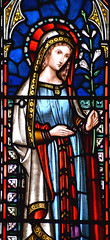  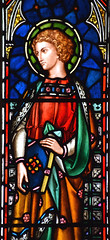 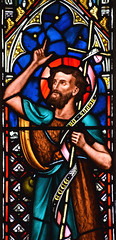
I find it hard to warm
to Hakewill's work. His introduction of high gloom into
the churches he restored seems intentional, and is often
coupled with low aisles that only increase the austerity.
Luckily, the great aisles here make the nave as wide as
it is long, and you step in to a feeling of lightness.
The great tower arch contains a modern ringing chamber in
light wood, which looks splendid, and suggests that
Cambourne's work is still very much appreciated.
One of the best things about this church is its
scattering of 14th and 15th Century glass, Some of which
is unusual, but all of it quite heavily restored. In the
upper lights of the south chancel window are angels of
the Precious Blood swinging censers. Christ in Majesty is
at the top, and the two figures either side are two Marys
and St John, reset here from a rood group.
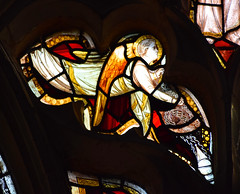 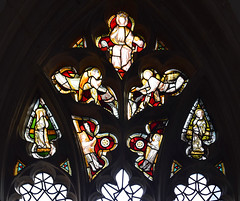 
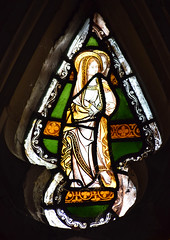  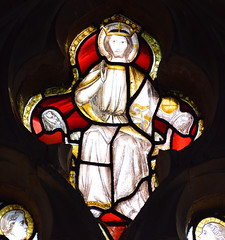 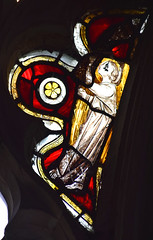 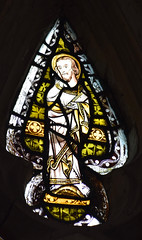
The font is set
against a pillar in the south arcade in the traditional
manner, and is one of those arcaded octagonal fonts you
find mainly in the east of the county, usually made from
Purbeck marble. Or, at least, it appears to be, but I
couldn't help wondering if it was actually an older,
square font that had been cut down and decorated by
someone locally. It just doesn't have the same finish as
other fonts in this style. The benches are Victorian, and
there are some hefty bench end carvings. Mortlock thought
they might be from the studio of the great Ipswich
woodcarver Henry Ringham, whose work is much in evidence
up the road in Woolpit, but I wasn't so sure. They don't
seem to me to be of the usual delicacy of his work. The
dove with an olive branch, for example, looks more like a
chicken.
There are also a couple of medieval bench ends at the
back, and they repay more than a passing glance. Although
the bench ends are very badly damaged, they both have
carvings on them. One is an angel who has had his front
neatly sliced off, presumably by an iconoclast to
eradicate the design on his shield, while the other is a
version of the carving at Blythburgh which is often
referred to as 'scandal' - a face carved into the
poppyhead with an outstretched tongue.There is another
near here at Bradfield St George. This version is rather
more elaborate than those two, because there are two
further heads sticking out their tongues to left and
right beneath the top head, and they have not been
vandalised like he has.
Despite being repainted, the roodscreen is beautiful, the
upper tracery boiling like lace into the air. The
roodloft stairway set in the north wall beside it is one
of the most complete in Suffolk, retaining all its
original steps and even the handrail. There is a very
curious stone platform stretching west of here. Today it
is used for the lectern, but it may have been part of a
tombchest originally, or even what Mortlock calls a
preaching platform. It is certainly very unusual.
The drop-sill sedilia in the sanctuary has lost its
arching, but the wooden panelling set into the back of it
is medieval. Perhaps it came from the roodloft here. It
was probably set there during the 19th century
restoration, and may have come from anywhere originally,
I suppose.
The family at Drinkstone Hall for many years were the
Grigbys, and they've left their mark here. Two matching,
elegant 18th century memorials with urns on flank the
vestry door, with a simpler one above.
But more interesting are
two memorials, one in the nave, the other on the
north side of the chancel. Thomas Grigby was
killed in the Peninsula war of 1811 - on
board a transport bound for Cadiz, he was run
down by the Franchise frigate off Falmouth and
perished together with 233 souls. Almost
forty years later, during the Indian Mutiny,
fourth son of the Rector John Peloquin Cosserat
was shot in the mouth by a musket ball while
commanding his regiment the first Punjaub Cavalry
against the rebels at Koorsee, an incident
which seems to have stepped out of the pages of The
Siege of Krishnapur.
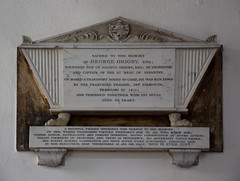 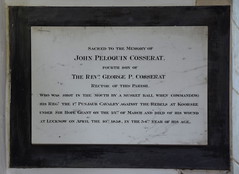
As you can
see, All Saints is full of interest. It doesn't
wear its heart on its sleeve, and there must be
very few of the many hundreds who visit Woolpit
every year who ever make it down the road to
here. I wandered around the graveyard in the
sunshine. Although the area to the west of the
tower has been partly cleared, the rest is fun to
explore, with lots of 19th century graves and
even some 18th century survivals. The massive yew
tree by the south porch must have seen a fair few
funeral processions in its time. I wandered
further eastwards, and, as I approached it, one
of the largest cats I've ever seen bestirred
itself lazily from the long grass and wandered
off. I guess there must be rich pickings for a
hunting cat in a place like this.
And there are riches for church explorers in this
area, many of them as little known as Drinkstone.
The next parishes in each direction are Gedding,
Rattlesden, and the wonderful Hessett, all worth
an hour of your time, all as open and welcoming
as this one.
|
Simon Knott, October 2019
Follow these journeys as they happen at Last Of England
Twitter.
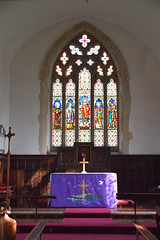  
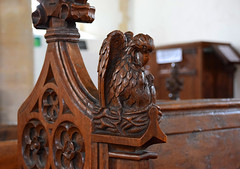 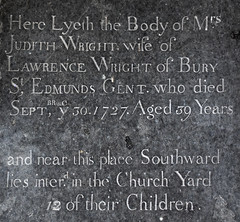 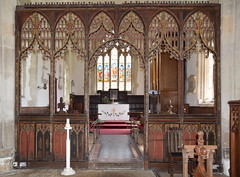
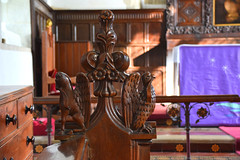 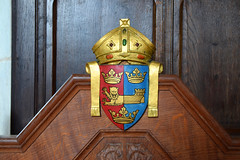 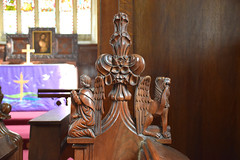
 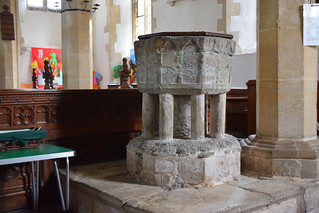 
|
|

